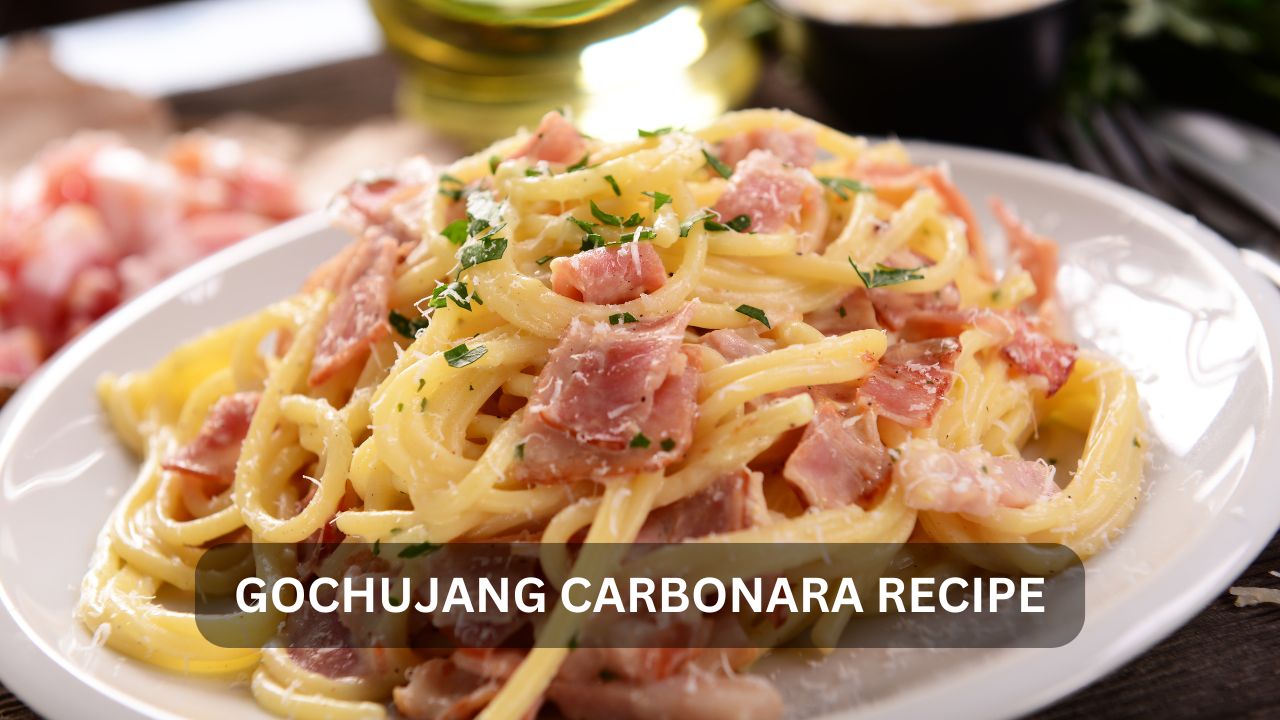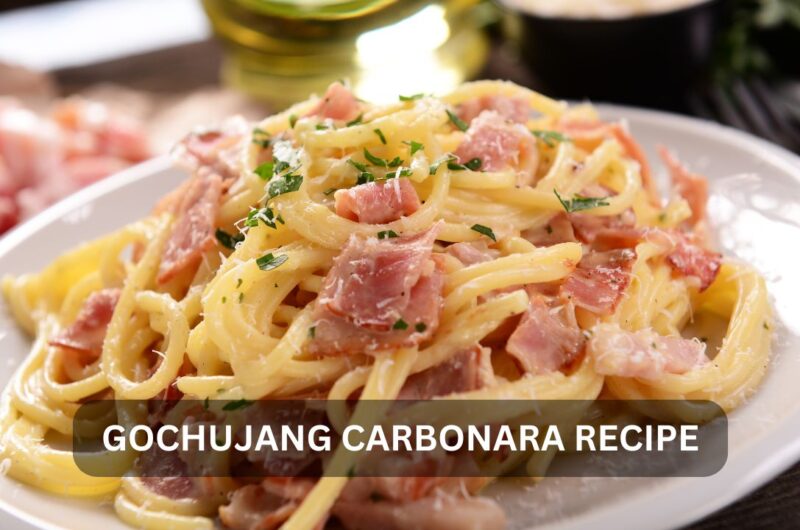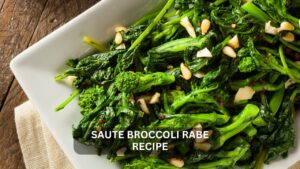In the endlessly inventive world of culinary innovation, fusion cuisine stands out as a thrilling adventure where the established boundaries of traditional food are playfully pushed and blended, giving rise to unexpectedly delightful culinary masterpieces. One of the most fascinating examples of this trend is the innovative fusion of Korean and Italian cuisines. This culinary experiment weaves together a complex and intricate tapestry of flavors, textures, and aromas that captivate and tantalize the taste buds of food enthusiasts around the globe. At the heart of this remarkable culinary crossroad is the mesmerizing gochujang carbonara, which symbolizes the perfect harmony between the bold, spicy flavors of Korean gochujang paste and the creamy, comforting essence of Italian carbonara. This dish is a testament to the creativity and ingenuity of chefs who dare to imagine and realize the full potential of combining diverse culinary traditions, creating a truly unique and unforgettable dining experience.
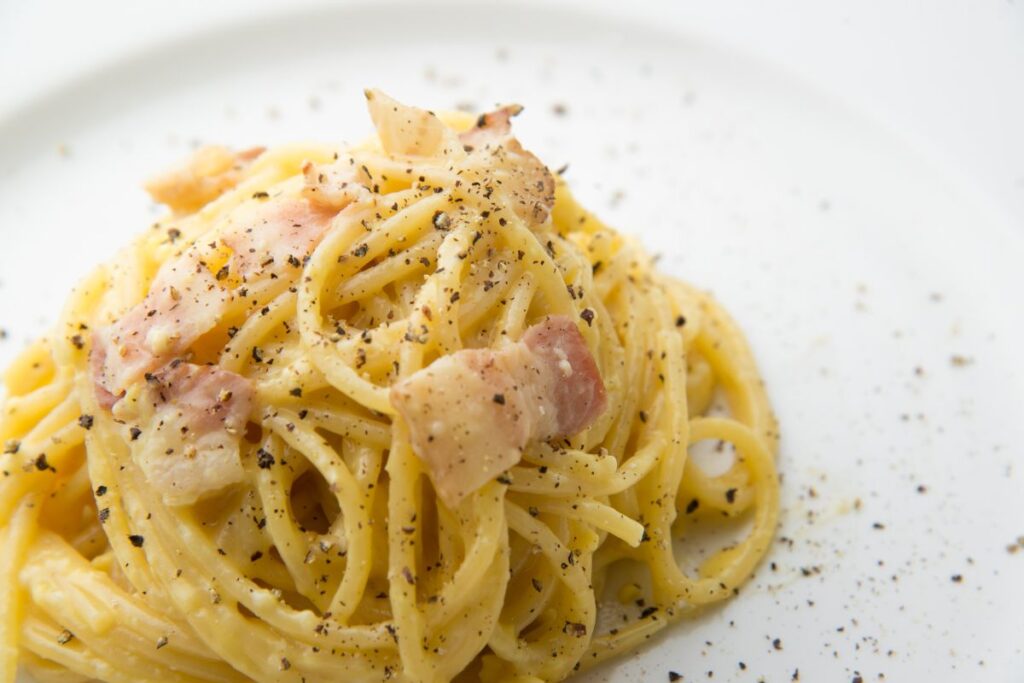
Gochujang in the Limelight
Before we plunge into the creamy depths of gochujang carbonara, it’s paramount to understand the luminous role gochujang plays in Korean cuisine. A staple in countless dishes, gochujang — a fermented red chili paste — embodies the heart and soul of Korea’s diverse flavor landscape. With a harmonious blend of heat, sweetness, and earthiness, gochujang is as versatile as it is distinct and revered for its depth in taste and tradition.
A Brief Gochujang Odyssey
The history of gochujang dates back to the Joseon Dynasty, where its use transformed over centuries, finally solidifying its place in Korean households as a foundational condiment. A testament to the rich heritage of Korean food, gochujang stands the test of time, offering an unyielding bridge between past and present.
Understanding the Flavor of Gochujang
To harness the full potential of gochujang, one must appreciate its flavor dynamics — the spicy kick, the subtle sweetness, and the mellow undercurrent of umami depth. These elements synergize beautifully to elevate any dish, infusing it with complex layers that intrigue the palate.
Gochujang’s Versatility
From stews to marinades, gochujang adds a bold character, playing the lead or supporting role with equal flair. This chameleon ability ensures that gochujang seamlessly integrates into many cuisines, offering a global passport to Korean essence.
The Fermentation Factor
The secret to gochujang’s robust flavors lies in its fermentation process, a noble tradition passed down through generations. This artisanal alchemy boosts taste and enriches gochujang with beneficial bacteria, fostering a healthy gut biome. This duality of health and taste makes gochujang an indispensable component of modern gastronomy.
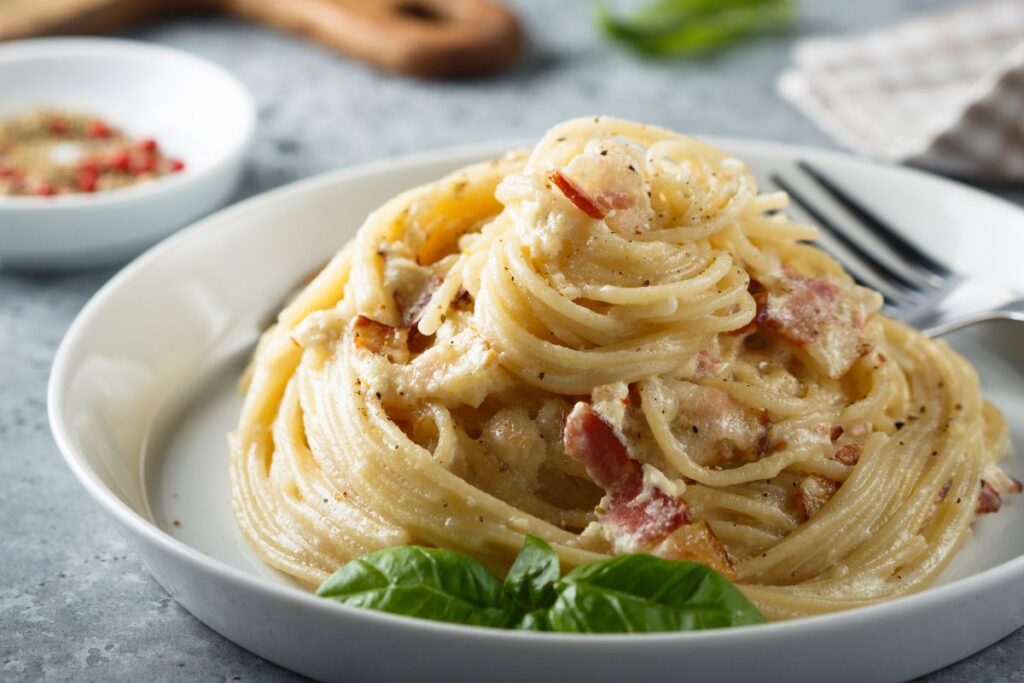
The Fusion Masterpiece: Gochujang Carbonara Recipe
With reverence to the lush pasta of Italy and the fiery spirit of Korea, the gochujang carbonara is a dish to savor. Here’s a step-by-step guide to bringing this cross-cultural sensation into your kitchen:
Ingredients
- 8 ounces of pasta, preferably spaghetti or bucatini
- One tablespoon of olive oil
- 4 ounces of diced pancetta or bacon
- Three garlic cloves, minced
- Three large eggs
- 1 cup grated Pecorino Romano cheese
- One tablespoon gochujang
- Salt and black pepper to taste
- Chopped fresh parsley for garnish (optional)
Method
- Boil the pasta in salted water according to package instructions until al dente.
- While the pasta cooks, heat the olive oil in a large skillet over medium heat. Add the pancetta and cook until browned and crisp. Add the garlic and cook for an additional 30 seconds.
- In a bowl, whisk together the eggs, grated Pecorino Romano cheese, gochujang, salt, and black pepper.
- When the pasta is ready, please remove it from the pot with tongs (reserving the pasta water) and add it to the skillet with the pancetta. Toss to coat the pasta in the fat.
- Remove the skillet from the heat and pour the egg and cheese mixture over the pasta. Working quickly, vigorously toss the pasta to combine. The heat from the pasta will cook the eggs, creating a creamy sauce. If the sauce is too thick, add some pasta water to thin it out.
- Serve immediately, garnished with chopped parsley if desired.

Tips for Perfection
The art of carbonara lies in mastering the sauce’s creaminess without scrambling the eggs. To ensure a velvety result:
- Work swiftly and off the heat when combining the egg and cheese mixture with the pasta.
- Use the residual heat of the cooked pasta to set the eggs, gently creating the quintessential creamy enchantment.
- Stir vigorously to distribute the sauce evenly and create a glossy texture.
- Reserve some pasta water in case the sauce needs thinning out.
- Experiment with different types of pasta, such as rigatoni or farfalle, to add texture to the dish.
Pairing and Presentation
The gochujang carbonara is a dish that not only stands tall on its own culinary merits but also dances gracefully with various accompaniments, elevating the dining experience. With its refreshing zing, a light, citrusy salad could serve as a perfect palatal interlude, cleansing the taste buds and preparing them for the next delicious bite. Alternatively, pair it with a velvety red wine for a more lavish and indulgent affair. Choose a wine that can waltz elegantly with the robust and spicy flavors of the dish, enhancing each mouthful with its rich, deep notes.
Presentation plays a crucial role in the aesthetic experience of this unique crimson-and-cream creation. To elevate its visual appeal, consider sprinkling extra Pecorino Romano on top for a snow-like finish that looks spectacular and adds a sharp, salty flavor that contrasts beautifully with the spicy, creamy sauce. An artistic drizzle of gochujang across the plate is a tantalizing visual prelude to the feast awaiting. This enhances the dish’s visual appeal and hints at the complex flavors to come, inviting diners to dive into a culinary journey that is as visually stunning as it is delicious.
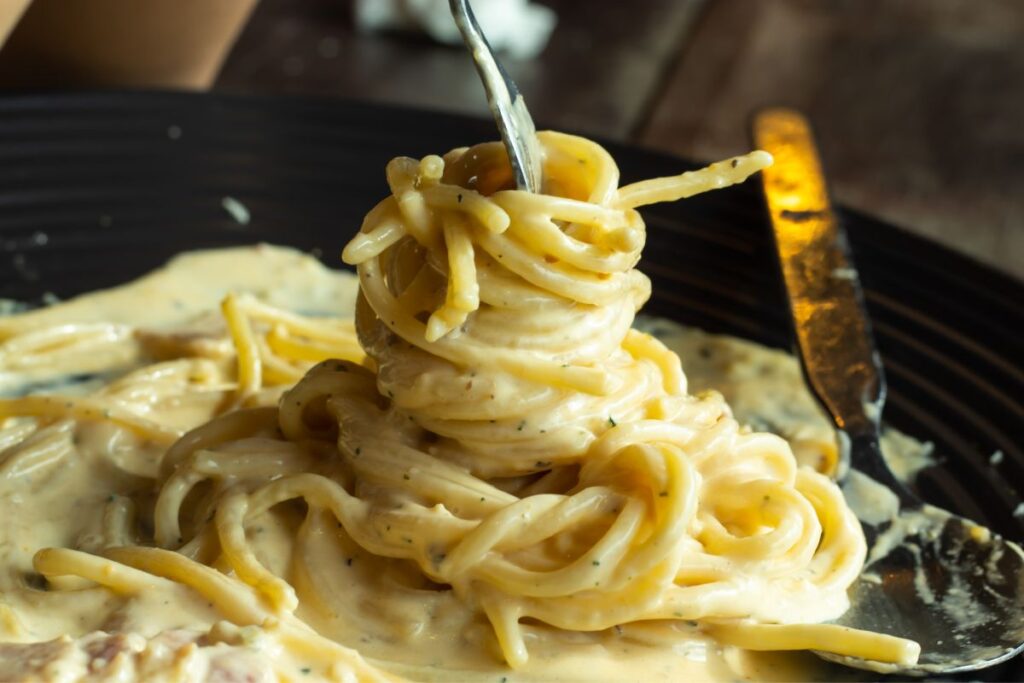
Health and Harmony With Gochujang
Gochujang, the Korean fermented chili paste, infuses the gochujang carbonara with its vivid and dynamic flavors and brings a wealth of health benefits to the table. Packed with protein, an array of vitamins, and essential minerals, gochujang is a wise choice for anyone looking to enrich their diet in a flavorful way. It contributes significantly to a balanced diet by offering support to the body’s essential functions, such as muscle building and immune system bolstering. Moreover, gochujang’s controlled but noticeable heat acts as a metabolic stimulant, gently nudging the body’s calorie-burning mechanisms into a higher gear. This can be particularly beneficial for those looking to maintain a healthy weight or boost their metabolism. The addition of gochujang to dishes such as carbonara transforms them into culinary delights that not only tantalize the taste buds but also contribute positively to overall health.
Personalizing Your Gochujang Carbonara
One of the joys of home cooking is the freedom to tweak recipes according to your preferences. Here are some ideas to personalize your gochujang carbonara:
- For an extra kick, add a touch of Korean chili flakes (gochugaru) to the pancetta as it cooks.
- Add a splash of soy sauce or a dollop of miso to the egg and cheese mixture if you want to up the umami factor.
- Vegetarian or vegan? Swap out the pancetta for sautéed mushrooms or crispy tofu, use an egg substitute, and opt for a plant-based cheese alternative.
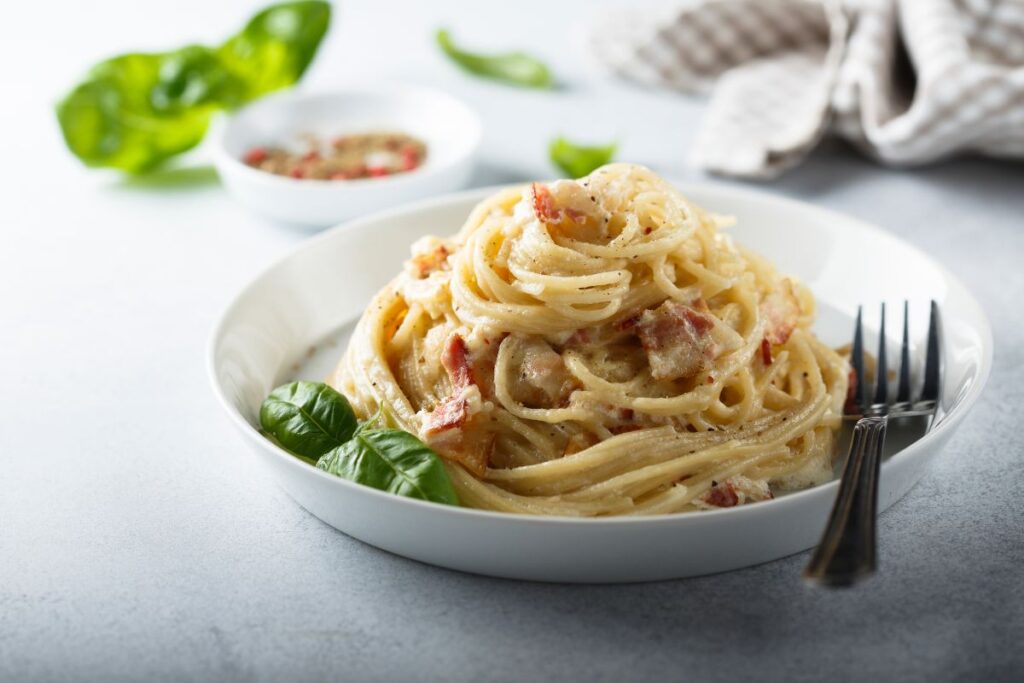
Pairing and Serving Your Gochujang Carbonara
Pairing suitable beverages with this dish elevates the dining experience, turning it into an art form that complements the culinary craftsmanship involved in its creation. The spicy kick provided by the gochujang adds depth to the dish and sets the stage for a bold beverage pairing. For those who appreciate the complexity of a good wine, a robust red wine like Sangiovese can stand up to the spice and enhance the overall flavor profile. Alternatively, hop-forward craft beer can offer a refreshing contrast to the heat, with its bitterness cutting through the dish’s richness. For those preferring a non-alcoholic option, a crisp ginger beer provides a spicy yet sweet counterbalance that mirrors the dish’s intensity. To complete the meal, serving the gochujang carbonara with a simple side salad, lightly dressed in a zesty citrus vinaigrette, helps cleanse the palate. This allows each mouthful of vibrant flavors to be fully appreciated, making the dining experience even more enjoyable.
Uncovering the Health Benefits of Gochujang Carbonara
Despite its rich and indulgent reputation, the gochujang carbonara is not devoid of health benefits — especially when prepared with fresh, high-quality ingredients. Opting for whole grain or legume-based pasta introduces a healthier twist to the traditional dish, serving as a potent source of fiber and protein essential for maintaining digestive health and muscle strength. The eggs, a vital component of the carbonara, contribute significantly to the dish’s protein content and are also a rich source of essential B vitamins that support energy levels and brain function. The gochujang, a Korean fermented chili paste, not only adds a unique depth of flavor but also brings the gut-health benefits of probiotics, promoting a healthy digestive system. Furthermore, incorporating heart-healthy olive oil enriches the dish with monounsaturated fats, which are known for reducing heart disease risk. The addition of garlic not only heightens the flavor profile but also provides anti-inflammatory and immune-boosting properties. These carefully chosen ingredients amalgamate into a dish that satisfies the soul, tantalizes the taste buds, and contributes positively to the body’s overall well-being, making the gochujang carbonara a delightful paradox of indulgence and health.

The Cultural Significance of Fusion Dishes
The creation of fusion dishes, such as the innovative gochujang carbonara, transcends mere culinary experimentation to become a significant cultural phenomenon. This blending of culinary traditions symbolizes a rich global exchange of ideas, flavors, and traditions, highlighting food’s incredible potential to unite people from disparate backgrounds. Fusion cuisine is a beautiful manifestation of how diverse cultures can find harmony and common ground through the universal language of food. By integrating ingredients and cooking techniques from various parts of the world, these dishes tell a story of collaboration, curiosity, and respect. It’s a living testament to the open-mindedness, adventurous spirit, and creative ingenuity of home cooks and professional chefs alike, who dare to explore beyond traditional boundaries and create something truly unique. Their efforts demonstrate a deep appreciation for the world’s culinary diversity and a desire to celebrate it, making fusion cuisine a vibrant and ever-evolving art form.
The Gochujang Carbonara and the Home Cook’s Artistry
For the home cook, every recipe is not just a set of instructions but a canvas waiting to be painted with the brushstrokes of personal flair. Whether it’s a pinch of exotic spice, a substitution to accommodate a dietary need, or a story behind the ingredients, the individual touch is what transforms a dish into a masterpiece.
With the gochujang carbonara, you have the chance to weave your narrative into a tapestry of two historical cuisines. Every twist and turn takes the traditional carbonara on a new adventure that you uniquely orchestrate. Share your experiences with us; how did your gochujang carbonara turn out? Did you add an element that you think others would love? The conversation on fusion cuisine is as dynamic and rich as the flavors it brings forth, and your voice adds to its splendor. In the kitchen, as in life, the joy is in the blend.
Gochujang Carbonara: A Spicy Twist on an Italian Classic
Course: DinnerCuisine: ItalianDifficulty: Easy6
servings10
minutes35
minutes574
kcalWelcome to the fusion kitchen, where Italian cuisine meets Korean flair! Are you ready for a culinary adventure that will tantalize your taste buds? If you like bold flavors and creamy pasta, our gochujang carbonara recipe will become a new favorite. This dish retains the creamy comfort of traditional carbonara but adds a spicy and savory twist with gochujang paste.
Ingredients
200g dried spaghetti
Two tablespoons of gochujang paste
Three tablespoons soy sauce
Two tablespoons honey
150g bacon, chopped
Three cloves garlic, minced
Two eggs
1/4 cup grated Parmesan cheese
One tablespoon of olive oil
Salt, to taste
Freshly ground black pepper, to taste
Chopped green onions for garnish
Directions
- Cook the Pasta:
Begin by cooking your spaghetti in a pot of boiling salted water until it reaches the perfect al dente texture. Once done, drain the pasta, but keep 1/2 cup of the pasta water for later use. - Create Your Gochujang Mixture:
Whisk together the intensely flavorful gochujang, soy sauce, and honey in a small mixing bowl. This is where the real magic begins! Set this mixture aside to infuse later on. - Fry Up the Bacon:
Heat olive oil in a skillet over medium heat, then toss the chopped bacon. Watch as it crisps up beautifully. Stir in the minced garlic and cook it for an additional minute, allowing the aromas to meld. - Combine the Flavors:
Lower your heat and add the gochujang mixture into the skillet, stirring to combine it with the garlicky, crispy bacon. - Prepare the Egg Mixture:
Whisk together raw eggs, generous shavings of Parmesan cheese, and a dash of black pepper in another bowl. - Bringing It All Together:
1. Toss the cooked spaghetti into the skillet, ensuring each strand is lovingly coated in the rich, spicy sauce. If the sauce feels too thick, loosen it with the reserved pasta water.
2. Take the skillet off the heat to keep the eggs from scrambling. Pour in the egg and cheese mixture immediately, stirring quickly to create a smooth, glossy sauce that envelops the pasta in creamy goodness. - Final Touches and Serve:
Season the gochujang carbonara with salt and black pepper according to your liking. Dish up the pasta into bowls and garnish with a sprinkle of fresh green onions for that extra pop of flavor and color.
Recipe Video
For more delicious homemade cook recipes, check out here-
- How to Cook Homemade Hawaiian Roll Cheeseburger Sliders
- How to Cook Dan Dan Noodle Recipe
- How to Cook Garlic Parmesan Wings Wingstop
- How to Cook Maque Choux Recipe
- How to Cook One Pan Tuscan Chicken
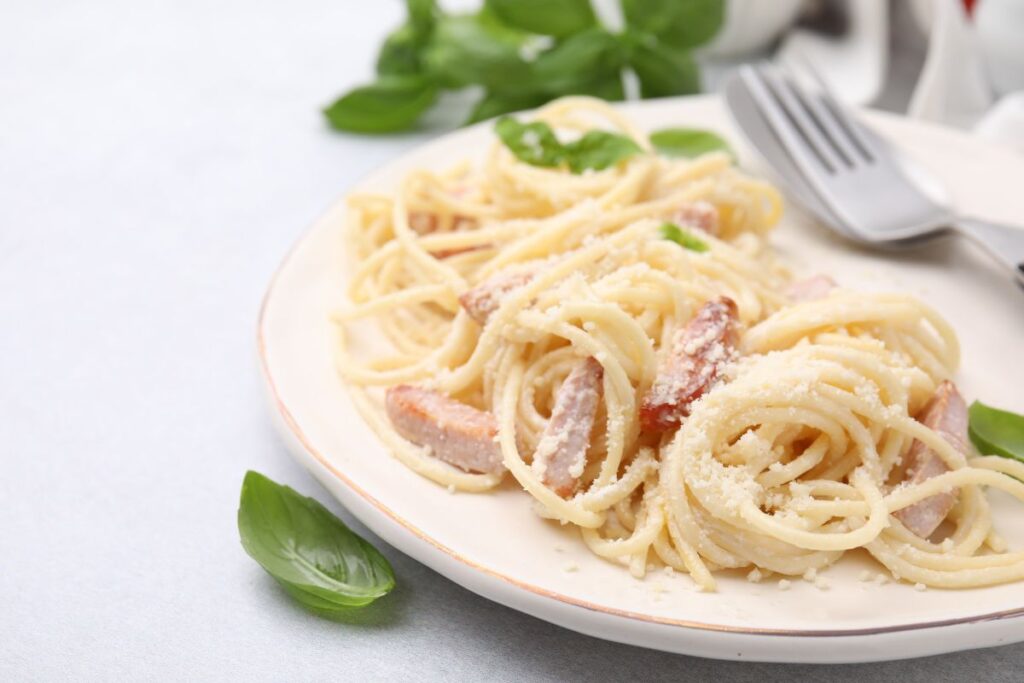
Conclusion
The gochujang carbonara is a culinary masterpiece that bridges continents and palates, inviting us to celebrate the harmonious blend of seemingly disparate cuisines. This dish is a testament to the virtues of cultural interplay and showcases the boundless spirit of creativity that flourishes in the kitchen. It ingeniously combines the rich, creamy texture of Italian carbonara with the spicy, umami-packed depth of Korean gochujang, creating a fusion feast that is both bold and comforting.
I warmly invite you to embark on this culinary journey and indulge in this dish’s rich flavors and innovative spirit. But the experience continues after the last bite. Share your gastronomic adventures with friends and family, for great food is more than just sustenance—the tapestry binds us together in shared joy and discovery. Savor every bite, relish in the blend of flavors, and spread the love for this innovative recipe.
Your dinner table has just transformed into a stage for global culinary brilliance, with gochujang taking the spotlight. This dish not only satisfies hunger but also ignites a passion for exploring the endless possibilities that come from combining the world’s culinary traditions. So, as you enjoy this masterpiece, remember that you are not just tasting a dish but participating in a global dialogue of flavors. Enjoy every bite, and let the love for inventive cooking shine through.

Reference
Frequently Asked Questions (FAQs) about Gochujang Carbonara
Can I use bacon instead of pancetta?
Yes, bacon can be a good substitute for pancetta in this recipe. While pancetta is a bit more delicate in flavor and less smoky compared to bacon, using bacon will still yield a delicious dish with a slightly different, smokier character.
What type of pasta is best for carbonara?
While spaghetti is the traditional pasta used for carbonara, you can use any long pasta, such as linguine, fettuccine, or bucatini. The key is to use pasta that can hold the creamy sauce well.
Is there a vegetarian option for this recipe?
For a vegetarian version, omit the pancetta and add sautéed mushrooms or zucchini for a savory flavor. You can also add smoked paprika to emulate a hint of smokiness.
How spicy is gochujang carbonara?
The spice level of gochujang carbonara can vary based on the brand and amount of gochujang paste used. Start with a smaller amount and adjust according to your tolerance to spice. Gochujang has a deep flavor profile that is not just about heat but also offers sweetness and umami.
Can I make this recipe gluten-free?
To make gochujang carbonara gluten-free, use your favorite gluten-free pasta and ensure that the gochujang paste and other ingredients like cheese and pancetta are gluten-free. Always read labels carefully to avoid hidden gluten.
How long does gochujang carbonara keep in the fridge?
If you have leftovers, gochujang carbonara can be stored in an airtight container in the refrigerator for up to 3 days. The pasta may absorb some of the sauce, making it less creamy upon reheating. Gently reheat on the stove with a splash of water or milk to bring back some of the sauce’s silkiness.
Can I freeze gochujang carbonara?
It’s not recommended to freeze gochujang carbonara. Pasta dishes with egg-based sauces like this can change texture significantly when frozen and reheated, leading to a less desirable consistency.

